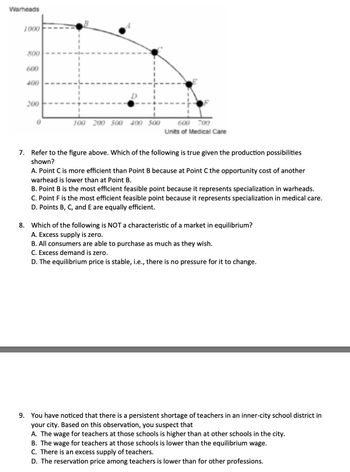
ENGR.ECONOMIC ANALYSIS
14th Edition
ISBN: 9780190931919
Author: NEWNAN
Publisher: Oxford University Press
expand_more
expand_more
format_list_bulleted
Question
None

Transcribed Image Text:Warheads
1000
800
600
400
200
100 200 300 400 500
600 700
Units of Medical Care
7. Refer to the figure above. Which of the following is true given the production possibilities
shown?
A. Point C is more efficient than Point B because at Point C the opportunity cost of another
warhead is lower than at Point B.
B. Point B is the most efficient feasible point because it represents specialization in warheads.
C. Point F is the most efficient feasible point because it represents specialization in medical care.
D. Points B, C, and E are equally efficient.
8. Which of the following is NOT a characteristic of a market in equilibrium?
A. Excess supply is zero.
B. All consumers are able to purchase as much as they wish.
C. Excess demand is zero.
D. The equilibrium price is stable, i.e., there is no pressure for it to change.
9. You have noticed that there is a persistent shortage of teachers in an inner-city school district in
your city. Based on this observation, you suspect that
A. The wage for teachers at those schools is higher than at other schools in the city.
B. The wage for teachers at those schools is lower than the equilibrium wage.
C. There is an excess supply of teachers.
D. The reservation price among teachers is lower than for other professions.
Expert Solution
This question has been solved!
Explore an expertly crafted, step-by-step solution for a thorough understanding of key concepts.
Step by stepSolved in 2 steps

Knowledge Booster
Similar questions
- Jeff, a 56 year old professor is subject to a 28% tax rate. He has had a family emergency and must withdraw $5,000 from his IRA to fund it. How much money will he owe the government for this withdrawal?arrow_forwardA compulsary legal and unilateral payment made to the government is known as _______arrow_forwardAnalyse how macro environmental factors ( PESTLE) affect a hotel organization.arrow_forward
Recommended textbooks for you

 Principles of Economics (12th Edition)EconomicsISBN:9780134078779Author:Karl E. Case, Ray C. Fair, Sharon E. OsterPublisher:PEARSON
Principles of Economics (12th Edition)EconomicsISBN:9780134078779Author:Karl E. Case, Ray C. Fair, Sharon E. OsterPublisher:PEARSON Engineering Economy (17th Edition)EconomicsISBN:9780134870069Author:William G. Sullivan, Elin M. Wicks, C. Patrick KoellingPublisher:PEARSON
Engineering Economy (17th Edition)EconomicsISBN:9780134870069Author:William G. Sullivan, Elin M. Wicks, C. Patrick KoellingPublisher:PEARSON Principles of Economics (MindTap Course List)EconomicsISBN:9781305585126Author:N. Gregory MankiwPublisher:Cengage Learning
Principles of Economics (MindTap Course List)EconomicsISBN:9781305585126Author:N. Gregory MankiwPublisher:Cengage Learning Managerial Economics: A Problem Solving ApproachEconomicsISBN:9781337106665Author:Luke M. Froeb, Brian T. McCann, Michael R. Ward, Mike ShorPublisher:Cengage Learning
Managerial Economics: A Problem Solving ApproachEconomicsISBN:9781337106665Author:Luke M. Froeb, Brian T. McCann, Michael R. Ward, Mike ShorPublisher:Cengage Learning Managerial Economics & Business Strategy (Mcgraw-...EconomicsISBN:9781259290619Author:Michael Baye, Jeff PrincePublisher:McGraw-Hill Education
Managerial Economics & Business Strategy (Mcgraw-...EconomicsISBN:9781259290619Author:Michael Baye, Jeff PrincePublisher:McGraw-Hill Education


Principles of Economics (12th Edition)
Economics
ISBN:9780134078779
Author:Karl E. Case, Ray C. Fair, Sharon E. Oster
Publisher:PEARSON

Engineering Economy (17th Edition)
Economics
ISBN:9780134870069
Author:William G. Sullivan, Elin M. Wicks, C. Patrick Koelling
Publisher:PEARSON

Principles of Economics (MindTap Course List)
Economics
ISBN:9781305585126
Author:N. Gregory Mankiw
Publisher:Cengage Learning

Managerial Economics: A Problem Solving Approach
Economics
ISBN:9781337106665
Author:Luke M. Froeb, Brian T. McCann, Michael R. Ward, Mike Shor
Publisher:Cengage Learning

Managerial Economics & Business Strategy (Mcgraw-...
Economics
ISBN:9781259290619
Author:Michael Baye, Jeff Prince
Publisher:McGraw-Hill Education